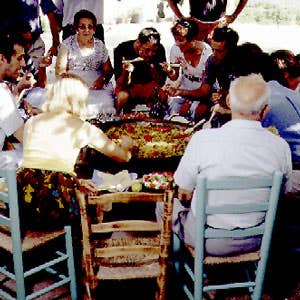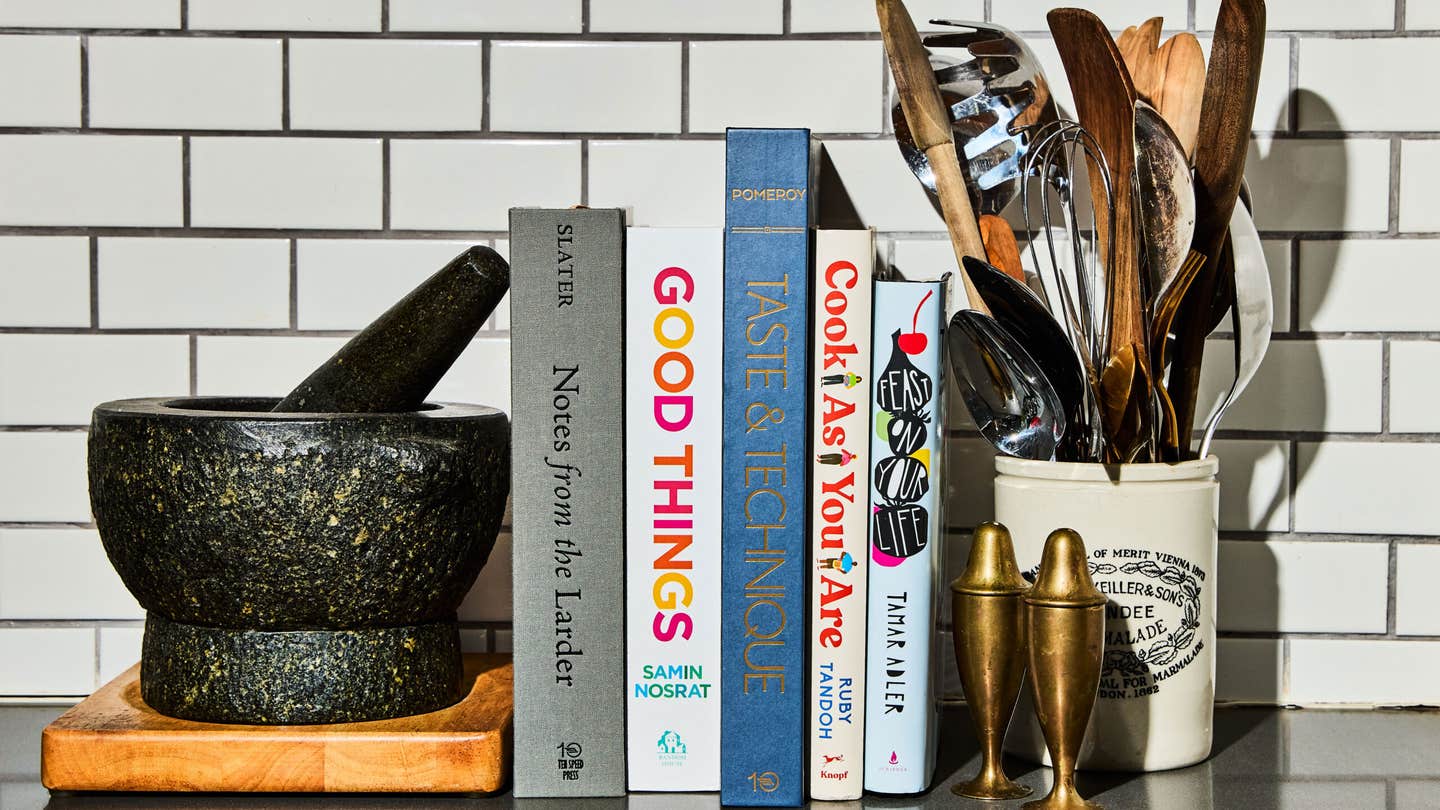
Paella as a Way of Life
In Valencia, this most famous of Spanish dishes is not some overloaded touristic casserole.
Outside Valencia's Gothic cathedral, on a bright Thursday morning, a crowd gathers. The Tribunal de las Aguas, one of the oldest and most unusual judicial institutions in Europe, is about to meet at the cathedral's Apostles Gate. Moments before noon, eight men in black robes part the masses, step inside a portable fence, and take their seats. The Tribunal de las Aguas convenes solely to resolve regional water disputes. There is no legal representation, no paper, no side-bar conferencing, just a defendant standing alone before the group of middle-aged farmers who will judge him. Today, there is only one case: A man is accused of shoveling dirt into a canal. He is found guilty and told to pay a fine and remove the dirt. The proceedings last two minutes.
The Tribunal de las Aguas has met for almost a thousand years—since the Moors occupied Valencia. The Moors left other legacies, too: date palms and orange groves; immense grids of huertas, or kitchen gardens; marshes planted with Valencia's famous rice—and, most important of all, the complex irrigation system, still in use today, that has made all of the rest of this possible. That system is what the tribunal regulates.
A city of about 2 million people, not quite halfway down the Mediterranean coast of Spain, Valencia is the birthplace of the world-famous (and almost inevitably bastardized) rice dish called paella—a Valencian institution to which the local water is also considered vital. Because water is different elsewhere, many local citizens believe paella simply doesn't taste the same away from the city. "Is the water really all that important to a good paella?" I can't resist asking Juan Alapont Polo, the acting president of the Tribunal de las Aguas, as the session breaks up. "Only as important as blood to a person!" he replies. "Not only is water needed in the cultivation of rice, of course, but the water here is full of calcium. That gives the paella its flavor."
Polo's friend Vicente Giner Boira, a renowned Valencian lawyer and an adviser to the tribunal, overhears our exchange. He looks at Polo with a disdainful stare. "The water isn't important," he says. "Water is water. What's important are the hands that make the paella. The genius. The inspiration. In other words, the chef. And the best paella chefs are in Valencia."
I've eaten paella all over Spain, always with a sense of obligation, because it is Spain's best-known culinary export—but also, invariably, with high expectations. I sensed that it had the potential to be a gastronomic triumph, a meal I would commemorate with stars in my Day-Timer and remember with a faraway look in my eyes. It never happened. Paella left me sated, but unmoved. Now, however, I've come to Valencia, the birthplace of paella, and I'm determined to taste the real thing at last—and to discover exactly what separates Valencian paella from all the others.
I quickly learn that what I've eaten as paella through the years—rice loaded up with shrimp, squid, sausage, chicken, peas, pimientos, and maybe hunks of fish—wasn't really paella at all. The original paella valenciana, Valencians agree, was a dish not of the seaside but of the huertas: saffron-flavored rice combined with rabbit and chicken, three kinds of beans, and snails in the shell. Seafood paella was a later invention, and, according to Valencians, is never made with meat or fowl.
That's about all they do agree upon. Can a woman cook a proper paella? Can it be eaten at night, or is it strictly a midday dish? Can it be finished in the oven after simmering over a flame? These are all points in dispute. Even where it should be eaten is argued about. Some say it's best at home or in the fields; others, that it's a restaurant dish. Some counsel a trip out of the city, while others maintain that, although the dish has rustic origins, it has been perfected by urban chefs. Even the term paella, I soon discover, has no fixed definition, and is now widely applied to all kinds of rice dishes in the region. The well-regarded Valencian rice restaurant called El Plat, for instance, offers paella with sardines, paella with salt cod, and paella with vegetables, among others—and when I start to order, Begoña Campos, whose family owns the place, talks me into trying one made with rabbit and artichokes. It arrives, darker brown than any paella I've seen, and the rice is perfectly cooked. After a mouthful, I'm certain that it is the best paella I've ever had. I eat every morsel—as if making up for all the misspent paellas of my youth.
But Begoña isn't through with me. She returns with a small plate of vegetable paella—rice enhanced with eggplant, artichokes, onions, peas, and peppers. I summarily revise my rankings: This is my favorite paella. But before I can ask for the check, she brings yet another one—a paella, full of squid, whose rice has been cooked in a concentrated fish stock instead of water. I stuff more rice into my mouth, under the guise of research.
As I finish, Begoña's father, Pascual, comes to my table to lecture me about rice. "There are 32 kinds of rice and not all are equal," he tells me. "Far from it! In most of the other restaurants, they use cheaper rice, but I use bomba especial. It's five or six times more expensive, but worth it, as you can tell." But, like Polo, Pascual Campos also stresses the importance of the water. "The water makes a big difference," he says. "There's stronger water, weaker water, more alkaline, less alkaline. That's why I would never order a paella away from Valencia; I'd have no confidence in it."
The next day, I drive a dozen miles or so south from Valencia to the seaside town of El Palmar, famous for its paella restaurants. The best of them, L'Establiment, is absurdly hard to find, tucked away down a dirt road alongside a canal, with rice paddies beyond. Strauss waltzes play on the sound system as Jose Luis Gonzalez, who runs the place, plies me with incredible tapas, including beans with blood sausage and the eel dish called all-i-pebre.
Then I sample two paellas: a black-rice version with squid (colored with squid ink), which is very good, and a traditional Valencian paella, which is even better. In the latter, the rice is just crunchy enough, but the assorted beans—broad, flat green ones; plump white ones; and big, soft, beige ones like overgrown limas—are the hidden delight, two or three to a forkful. I tell Gonzalez I prefer the traditional Valencian preparation, and for a moment I think he's going to hug me.
Across the rice paddies from El Palmar, in the town of Sueca, scientists at the Valencian Institute of Agrarian Investigation are hard at work analyzing countless varieties of rice in an attempt to maximize productivity and develop hardier strains. Yet the director of the institute's rice department, Rafael Ballesteros, downplays the role of rice in paella. "Even though I work with rice," he says, "I believe the flavor of the other ingredients is more important to the paella. I think of the rice as the margin of error. You can make a great paella with ordinary rice, but it's more difficult. At the same time, a good rice doesn't guarantee a good paella because there are other variables. For example, the water is very important, as I'm sure you already know."
Llorenç Millo is a prominent Valencian writer and the author of the definitive book on the region's cuisine, _La Taula i la cuina _(which might be loosely translated as "dining and cooking"). For some reason, Millo seems more interested in discussing trinquet—a mixture of jai alai and tennis played only in Valencia—than paella. Pressed for a connection, he insists that trinquet is a common topic of conversation over the paella pan. "When you make a paella in the country," he explains, "logically, you can talk about anything. But older men cook paellas more than younger men, so they discuss traditional things, like trinquet, bullfights, or the orange harvest."
Millo tells me about fideua, a "paella" made with the short, thin noodles called fideos—a variation said to have been invented in the beachfront restaurants of Gandia, about 40 miles south of Valencia. He also informs me that he thinks that seafood was first added to paella for commercial reasons at the beginning of this century. "Paella is very cheap compared to most dishes," he says, "so restaurants started adding seafood to justify charging more," he says. "I actually like it better made with seafood. Why? Farm-raised chicken is insipid, and the rice usually has little taste. You might as well have the seafood." Then he drops a bombshell: Few chefs in Valencia bother to use saffron in their rice anymore, he says. "They say they do, but they really use Yellow Dye No. 2."
Vincente Ruiz, the Valencian bullfighter nicknamed "El Soro", lives near Valencia, in the village of Foyos. I don't know him personally, but we have mutual friends, and I call to ask if he has any opinions about paella. As it turns out, Ruiz is in Madrid, but due home the next day—Mother's Day—and I am invited over for the occasion.
When I arrive the following afternoon, I find Vincente's younger brother Antonio, also a bullfighter, preparing a giant paella in the courtyard. In a pan the size of a medieval shield, he has combined rabbit, duck, chicken, green beans, artichokes, peppers, and rice, and is simmering it all over a wood fire—with, I must report, a vial of yellow powder within easy reach. I've had a lot of paella in the past few days, but the smell of the wood smoke gives me an appetite for it again. "Cooking paella is like bullfighting," says Vincente. "There are a million ways to do it. We have nine kids in our family and all of us cook paella differently. But Antonio's comes out the best of all." Antonio smiles, then shakes more dye into the pan.
Brothers and sisters arrive with spouses and children, and it occurs to me that three generations of extended family are about to eat a meal that originates in one pan. The symbolism is striking—and so is the aroma. Yet we seem no closer to beginning than we had been an hour before. "Hurry up, Antonio," his mother calls from inside the house. "We're all here, and we're all hungry." "Stay calm, Mom," Antonio replies. "Just a minute more." With the last bit of moisture gone, he removes the pan from the heat and sets it aside. He extends a hand towards the dish as if introducing it to an invisible audience, then turns to me with an enormous grin. "Art!" he says. "But now let's eat."
Keep Reading
Continue to Next Story










